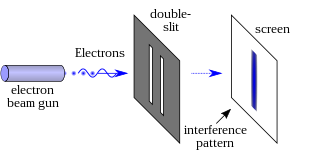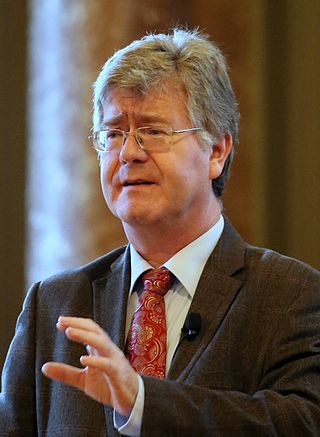
In modern physics, the double-slit experiment demonstrates that light and matter can satisfy the seemingly-incongruous classical definitions for both waves and particles, which is considered evidence for the fundamentally probabilistic nature of quantum mechanics. This type of experiment was first performed by Thomas Young in 1801, as a demonstration of the wave behavior of visible light. At that time it was thought that light consisted of either waves or particles. With the beginning of modern physics, about a hundred years later, it was realized that light could in fact show behavior characteristic of both waves and particles. In 1927, Davisson and Germer demonstrated that electrons show the same behavior, which was later extended to atoms and molecules. Thomas Young's experiment with light was part of classical physics long before the development of quantum mechanics and the concept of wave–particle duality. He believed it demonstrated that Christiaan Huygens' wave theory of light was correct, and his experiment is sometimes referred to as Young's experiment or Young's slits.

A photon is an elementary particle that is a quantum of the electromagnetic field, including electromagnetic radiation such as light and radio waves, and the force carrier for the electromagnetic force. Photons are massless, so they always move at the speed of light in vacuum, 299792458 m/s. The photon belongs to the class of boson particles.

Quantum mechanics is a fundamental theory in physics that provides a description of the physical properties of nature at the scale of atoms and subatomic particles. It is the foundation of all quantum physics including quantum chemistry, quantum field theory, quantum technology, and quantum information science.
Wave–particle duality is the concept in quantum mechanics that every particle or quantum entity may be described as either a particle or a wave. It expresses the inability of the classical concepts "particle" or "wave" to fully describe the behaviour of quantum-scale objects. As Albert Einstein wrote:
It seems as though we must use sometimes the one theory and sometimes the other, while at times we may use either. We are faced with a new kind of difficulty. We have two contradictory pictures of reality; separately neither of them fully explains the phenomena of light, but together they do.
In quantum mechanics, wave function collapse occurs when a wave function—initially in a superposition of several eigenstates—reduces to a single eigenstate due to interaction with the external world. This interaction is called an observation, and is the essence of a measurement in quantum mechanics, which connects the wave function with classical observables such as position and momentum. Collapse is one of the two processes by which quantum systems evolve in time; the other is the continuous evolution governed by the Schrödinger equation. Collapse is a black box for a thermodynamically irreversible interaction with a classical environment.

Quantum decoherence is the loss of quantum coherence, the process in which a system's behaviour changes from that which can be explained by quantum mechanics to that which can be explained by classical mechanics. In quantum mechanics, particles such as electrons are described by a wave function, a mathematical representation of the quantum state of a system; a probabilistic interpretation of the wave function is used to explain various quantum effects. As long as there exists a definite phase relation between different states, the system is said to be coherent. A definite phase relationship is necessary to perform quantum computing on quantum information encoded in quantum states. Coherence is preserved under the laws of quantum physics.
Matter waves are a central part of the theory of quantum mechanics, being half of wave–particle duality. All matter exhibits wave-like behavior. For example, a beam of electrons can be diffracted just like a beam of light or a water wave.
In physics, coherence expresses the potential for two waves to interfere. Two monochromatic beams from a single source always interfere. Physical sources are not strictly monochromatic: they may be partly coherent. Beams from different sources are mutually incoherent.
The classical limit or correspondence limit is the ability of a physical theory to approximate or "recover" classical mechanics when considered over special values of its parameters. The classical limit is used with physical theories that predict non-classical behavior.
In quantum physics, a measurement is the testing or manipulation of a physical system to yield a numerical result. The predictions that quantum physics makes are in general probabilistic. The mathematical tools for making predictions about what measurement outcomes may occur were developed during the 20th century and make use of linear algebra and functional analysis.
In quantum mechanics, the measurement problem is the problem of how, or whether, wave function collapse occurs. The inability to observe such a collapse directly has given rise to different interpretations of quantum mechanics and poses a key set of questions that each interpretation must answer.
The Afshar experiment is a variation of the double-slit experiment in quantum mechanics, devised and carried out by Shahriar Afshar while at the private, Boston-based Institute for Radiation-Induced Mass Studies (IRIMS). The results were presented at a Harvard seminar in March 2004. Afshar claimed that the experiment gives information about which of two paths a photon takes through the apparatus while simultaneously allowing interference between the two paths to be observed, by showing that a grid of wires, placed at the nodes of the interference pattern, does not alter the beams. Afshar claimed that the experiment violates the principle of complementarity of quantum mechanics, which states roughly that the particle and wave aspects of quantum objects cannot be observed at the same time, and specifically the Englert–Greenberger duality relation. The experiment has been repeated by a number of investigators, but its interpretation is controversial, and there are several theories that explain the effect without violating complementarity.

In solid-state physics crystal momentum or quasimomentum is a momentum-like vector associated with electrons in a crystal lattice. It is defined by the associated wave vectors of this lattice, according to

Electron optics is a mathematical framework for the calculation of electron trajectories in the presence of electromagnetic fields. The term optics is used because magnetic and electrostatic lenses act upon a charged particle beam similarly to optical lenses upon a light beam.
Quantum mechanics is the study of matter and its interactions with energy on the scale of atomic and subatomic particles. By contrast, classical physics explains matter and energy only on a scale familiar to human experience, including the behavior of astronomical bodies such as the moon. Classical physics is still used in much of modern science and technology. However, towards the end of the 19th century, scientists discovered phenomena in both the large (macro) and the small (micro) worlds that classical physics could not explain. The desire to resolve inconsistencies between observed phenomena and classical theory led to two major revolutions in physics that created a shift in the original scientific paradigm: the theory of relativity and the development of quantum mechanics. This article describes how physicists discovered the limitations of classical physics and developed the main concepts of the quantum theory that replaced it in the early decades of the 20th century. It describes these concepts in roughly the order in which they were first discovered. For a more complete history of the subject, see History of quantum mechanics.
Atom optics "refers to techniques to manipulate the trajectories and exploit the wave properties of neutral atoms". Typical experiments employ beams of cold, slowly moving neutral atoms, as a special case of a particle beam. Like an optical beam, the atomic beam may exhibit diffraction and interference, and can be focused with a Fresnel zone plate or a concave atomic mirror.
The Hartman effect describes how the delay time for a quantum tunneling particle is independent of the thickness of the opaque barrier. It is named after Thomas Hartman, who discovered it in 1962.
In physics, the observer effect is the disturbance of an observed system by the act of observation. This is often the result of utilizing instruments that, by necessity, alter the state of what they measure in some manner. A common example is checking the pressure in an automobile tire, which causes some of the air to escape, thereby changing the pressure to observe it. Similarly, seeing non-luminous objects requires light hitting the object to cause it to reflect that light. While the effects of observation are often negligible, the object still experiences a change. This effect can be found in many domains of physics, but can usually be reduced to insignificance by using different instruments or observation techniques.

Wolfgang P. Schleich is professor of theoretical physics and director of the quantum physics department at the University of Ulm.

Carlos Ray Stroud, Jr. is an American physicist and an educator. A pioneer in the field of quantum optics, Stroud has carried out theoretical and experimental studies in most areas of the field from its beginnings in the late 1960s, studying the fundamentals of the quantum mechanics of atoms and light and their interaction. He has authored over 140 peer-reviewed papers and edited seven books. He is a fellow of the American Physical Society and the Optical Society of America, as well as a Distinguished Traveling Lecturer of the Division of Laser Science of the American Physical Society. In this latter position he travels to smaller colleges giving colloquia and public lectures.








